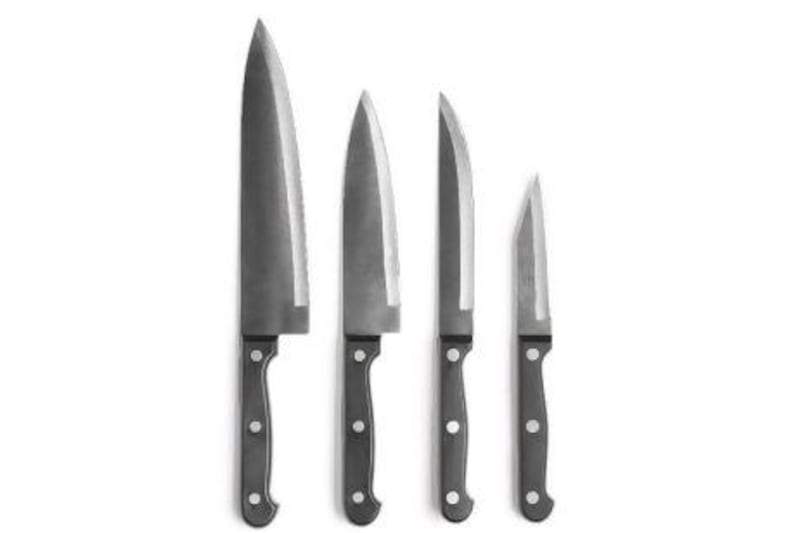How many knives do I really need?
According to the chef Jean-Christophe Novelli, you only need three: a small paring knife, a large meat cleaver and an elegant carving knife for special occasions. Many people would add a serrated bread knife to this list, so foodies generally agree that four is the magic number.
If you want to avoid washing up every five minutes, buy two of each. It's better to invest in a small number of top quality, useful knives than a lot of cheaper knives that can all perform similar tasks and won't last as long.
Twitter: The National Eats We've launched a new twitter feed devoted to all things food
Join The National's new twitter feed twitter.com/thenationaleats to view the latest in restaurant reviews, recipes, food safety, features and news.
[ twitter.com/thenationaleats ]
What kind of knife blade is best?
There are pros and cons with each type of blade. For example, stainless steel blades are affordable but can't ever be sharpened back to their original condition once they lose their edge.
Carbon steel blades will remain sharper for longer than standard stainless steel ones, but will discolour over time and are more susceptible to rust. High-carbon steel blades remain sharp for a long time, too, and won't discolour, but they're pricey.
Ceramic blades stay the sharpest for the longest, but they're fragile and easy to break. Look out for non-stick coated blades or those that have slight indentations in them to prevent sliced food from sticking as you cut.
What about handles?
Make sure to try before you buy whenever possible to find the most comfortable handle for your grip.
Knives with wooden handles look stylish but will warp over time even if you hand wash them. Plastic handles are hygienic because they don't absorb water, but can become brittle and crack, and some people find that plastic handles are too light to use comfortably.
Knives that are made of one piece of metal with no separate handle (known as full-tang knives) are the most durable, but can be heavy to use. Some manufacturers, especially Japanese brands, now give full-tang knives hollow handles to make them lighter and easier to use.
Many knives now come with soft-grip, ergonomically shaped composite handles, which are super-comfy to hold, so shop around.
How much should I expect to spend on a set of knives?
Prices vary tremendously. Ikea sells a cheap set of five kitchen knives in a plastic storage block for just Dh29, while good quality Richardson Sheffield Forme stainless steel kitchen knives start at around Dh50 for an 8cm paring knife and Dh96 for a 21cm carving knife at Lakeland (Mirdif City Centre and Mall of the Emirates).
More expensive, ice-tempered Japanese Global knives with sand-balanced hollow handles and Samurai sword technology - yes, really - start at around Dh266 for an 8cm paring knife and Dh397 for a 21cm carving knife, also at Lakeland.
Professional chefs are prepared to part with enormous sums of money for the latest, cutting-edge knives. Ziganof is about to launch a 21cm Japanese Connoisseur cleaver for a cool Dh1,412. It has a super-sharp blade with a surgical steel core, 66 layers of ultra-hard, folded Damascus steel and a moisture-resistant, hardwood antibacterial handle injected with resin. The matching 8cm Heirloom paring knife has an eye-watering price tag of Dh1,196.
As a general rule, buy the best knives you can afford - they're an investment and should last a long time if you care for them correctly.
What's the best way to care for knives?
Ideally, you should hand wash and towel dry knives immediately after using them to avoid rust and discolouration.
Keeping your knives sharp not only makes slicing food easier but also makes chopping safer. How often you need to sharpen your knives will depend on how often you use them, but when they appear to be losing their edge, use a whetstone sharpener gadget such as the Anolon Universal sharpener (Dh110, www.amazon.com) to restore the blades to their former glory.
Don't attempt to sharpen serrated knives. You'll just make them even more blunt.
How should I store my knives?
The safest option is to buy a knife block, so sharp blades can't be brushed against by accident. If your work-surface space is limited, consider storing your knives on a magnetic strip on the wall - the MIU France 15-inch stainless steel magnetic knife holder (Dh73, www.amazon.com) can be wall-mounted horizontally or vertically, so it's perfect for compact spaces.
Never store your knives in a drawer. Not only is it easy to cut yourself when you're in a rush, but the blades will brush against other utensils and become blunt far more quickly.
The jargon
Stainless steel Steel with chromium added to make it rust resistant
Carbon steel An alloy of carbon and iron. Very hard but may discolour over time. New carbon steel knives can give food a slightly metallic flavour
High-carbon steel A high grade alloy that combines the best attributes of stainless and carbon steel
Martensitic steel A low-carbon stainless steel alloy. Hard but can be brittle
Ice-tempered Stainless steel is cooled to 120 degrees below zero to make it super-strong
Sand-balanced A knife with a measured amount of sand in the handle to make it perfectly balanced and easy to use
Santoku A well-balanced Japanese kitchen knife between 13cm and 20cm long. Used for slicing, dicing and mincing
Tang The part of the knife blade that extends into the handle
Full-tang A knife that is made from one piece of metal, with the blade extending back to the handle. Hefty but expensive
Bolster The anchor point between the blade and the handle - often a ridge
Stamped A knife blade pressed out of a sheet of metal. Lightweight and good for fine cooking tasks such as filleting
Forged A knife blade moulded in high heat. Heavy and lasts for a long time





